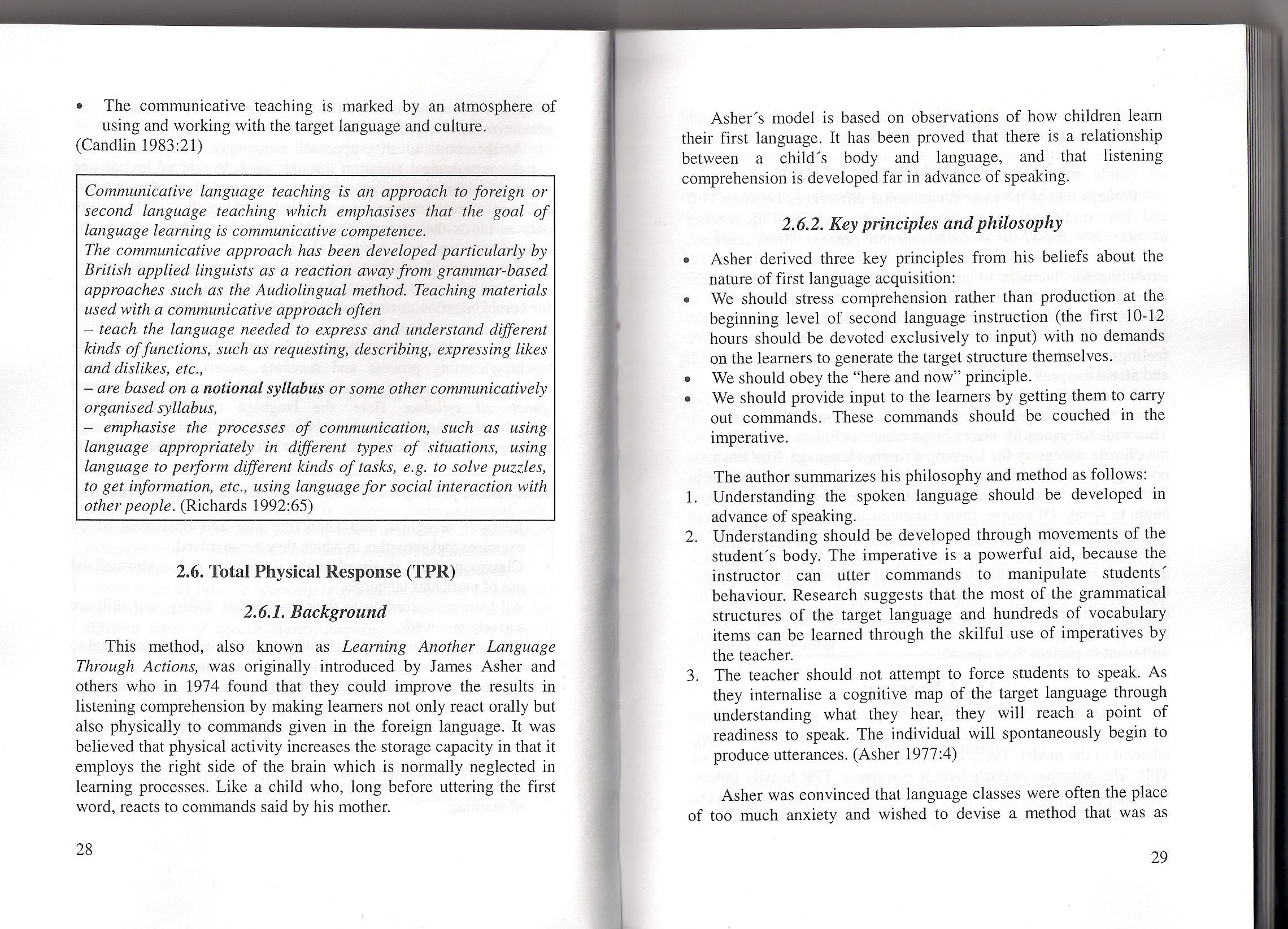skanowanie0014 (47)

• The communicative teaching is marked by an atmosphere of using and working with the target language and culture.
(Candlin 1983:21)
Communicative language teaching is an approach to foreign or second language teaching which emphasises that the goal of language leaming is communicative competence.
The communicative approach has been developed particularly by British applied linguists as a reaction awayfrom grammar-based approaches such as the Audiolingual method. Teaching materials used with a communicative approach often
- teach the language needed to express and understand dijferent kinds offunctions, such as reąuesting, describing, expressing likes and dislikes, etc.,
- are based on a notional syllabus or some other communicatively organised syllabus,
emphasise the processes of communication, such as using language appropriately in dijferent types of situations, using language to perform dijferent kinds of tasks, e.g. to solve puzzles, to get information, etc,, using language for social interaction with other people. (Richards 1992:65)
2.6. Total Physical Response (TPR)
2.6.1. Background
This method, also known as Leaming Another Language Through Actions, was originally introduced by James Asher and others who in 1974 found that they could improve the results in listening comprehension by making leamers not only react orally but also physically to commands given in the foreign language. It was believed that physical activity increases the storage capacity in that it employs the right side of the brain which is normally neglected in leaming processes. Like a child who, long before uttering the first word, reacts to commands said by his mother.
Asher's model is based on observations of how children learn their first language. It has been proved that there is a relationship between a child's body and language, and that listening comprehension is developed far in advance of speaking.
2.6.2. Key principles andphilosophy
• Asher derived three key principles from his beliefs about the naturę of first language acquisition:
• We should stress comprehension rather than production at the beginning level of second language instruction (the first 10-12 hours should be devoted exclusively to input) with no demands on the leamers to generate the target structure themselves.
• We should obey the “here and now” principle.
• We should provide input to the leamers by getting them to carry out commands. These commands should be couched in the imperative.
The author summarizes his philosophy and method as follows:
1* Understanding the spoken language should be developed in advance of speaking.
2. Understanding should be developed through movements of the studenfs body. The imperative is a powerful aid, because the instructor can utter commands to manipulate students' behaviour. Research suggests that the most of the grammatical structures of the target language and hundreds of vocabulary items can be learned through the skilful use of imperatives by the teacher.
3. The teacher should not attempt to force students to speak. As they intemalise a cognitive map of the target language through understanding what they hear, they will reach a point of readiness to speak. The individual will spontaneously begin to produce utterances. (Asher 1977:4)
Asher was eonvinced that language classes were often the place of too much anxiety and wished to devise a method that was as
29
Wyszukiwarka
Podobne podstrony:
skanowanie0014 (47) • The communicative teaching is marked by an atmosphere of using and working wit
26 (232) 72 Chapter 2 Every claim, reported by a customer, is registered by an employee of departmen
7 2 8 objectivity patiencesupport support is an activity, which creałes an atmosphere of approval an
7THE FIRST FLOOR Is approached by an exceptionally fine MASSIVE OAK STAIRCASE which is the feature i
27 (218) Modeling Workflows 73 First, the complaint is evaluated by a complaint manager of depart-me
2013 SYSTEMS SUPPORTING PRODUCTION ENGEINEERING field, what is revealed by a change in their posturę
SCAN0122 CHAPTER 2 ▼ Cornea and Selera 27FIGURĘ 2-17 Limbus. Limbal conjunctiva (A) is formed by an
skanowanie0048 (9) — model text — culture and background of the
V Assume that the test object can be represented by an n-degree-of-freedom lumped-parameter model(1)
5 (260) 18 The Grammar-Translation Mełhod aspect of the culture of the target language community. St
27 (216) Stamps and Multisets When a multiset that defines morę than one token is created, by an ini
Absolute chronology of the tumulus in Kolosy 159 approx. 3700 to approx. 3300 BC) were separated by
the paper is presented as an instrument of risk analysis operating lever-age, financial leverage and
więcej podobnych podstron